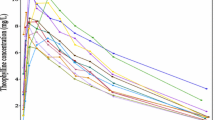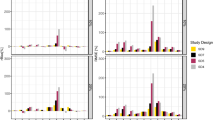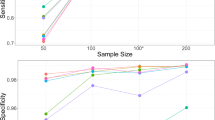Introduction. Two analytic strategies can be taken to the analysis of multi-response data: a multivariate output model can be fit to all the response components simultaneously (SIM), or each response component can be fit separately to a univariate output model, conditioning in some way on the non-modeled components, the so-called forcing function approach (FFA). Focusing on a special case of multi-response model corresponding to a (pharmacokinetic) physiological f low model (PFM), the aims of this study are to (i) provide an algorithm for applying FFA to multi-response data from a PFM; (ii) examine the performance of FFA vs. SIM under optimal conditions for both, and in the presence of model misspecification; (iii) make recommendations regarding the use of FFA for multi-response data analysis. Methods. The basic PFM we use (variants of the basic model are used for simulation) has four homogenous compartments among which drug distributes. All are sampled arterial blood (A), non-eliminating tissue (N), eliminating tissue (E), and venous blood (V), which is also the drug dosing site. Parameters are blood f low rates to E and N, volumes of distribution of A, E, N, and V, elimination rate constant from E, and observation error variances. Observations from a generic individual under various study designs and parameter values are simulated. Using data-analytic models (DAM) both the same as, and different than the data simulation model (DSM), SIM fits the PFM to all data simultaneously; FFA first fits each type of response (one per tissue) separately, approximating the tissue’s input by linearly interpolating the observed concentrations from the donor tissue(s), estimates the identifiable parameter combinations for the response type, and then solves the simultaneous equations linking these across tissues, to obtain the primary model parameters of interest. This simulation and analysis steps are repeated to generate reliable performance statistics. Performances are compared with respect to parameter estimation error (when DAM and DSM are identical), and interpolated prediction error (when DAM and DSM are/are-not identical).The ability of SIM and FFA to identify the correct analytic model is also examined by comparing their failure rates in rejecting the wrong DAM. Results. The parameter estimation errors with FFA are generally about two times greater than those with SIM when the DAM is identical to the DSM. The prediction errors of FFA are about ten times greater than those of SIM when the DAM is identical to the DSM, and are about three times greater when the two are different. However, SIM fails to identify the correct model twice as often as FFA. Conclusions. Despite its greater convenience for model building, and its clear advantages for model identification, FFA’s final parameter estimates cannot be trusted when the multi-response system being modeled involves feedback. The size of the ratio of the two FFA residuals (obtained from the response-specific fits and from predictions made with the final FFA parameters) can, however, be used to indicate when FFA’s final estimates may be trustworthy.
Similar content being viewed by others
References
D.M. Foster (1998) ArticleTitleDeveloping and testing integrated multicompartment models to describe a single-input multiple-output study using the SAAM II software system Adv. Exp. Med. Biol 445 59–78 Occurrence Handle9781382 Occurrence Handle1:STN:280:DyaK1cvlsVKltQ%3D%3D
K.E. Fattinger D. Verotta H.C. Porchet A. Munafo J.Y. Cotonnec ParticleLe L.B. Sheiner (1996) ArticleTitleModeling a bivariate control system: LH and testosterone response to the GnRH antagonist antide Am. J. Physiol 271 E775–787 Occurrence Handle8897868 Occurrence Handle1:STN:280:ByiD2MzjsFI%3D
J. Shi T. Ludden A.P. Melikian M.R. Gastonguay P.H. Hinderling (2001) ArticleTitlePopulation pharmacokinetics and pharmacodynamics of sotalol in pediatric patients with supraventricular or ventricular tachyarrhythmia J. Pharmacokin. Biopharm 28 555–575 Occurrence Handle1:STN:280:DC%2BD383lvF2itw%3D%3D
T. O’Hara S. Hayes J. Davis J. Devane T. Smart A. Dunne (2001) ArticleTitleIn vivo–in vitro correlation (IVIVC) modeling incorporating a convolution step J. Pharmacokin. Pharmacodyn 28 277–298 Occurrence Handle1:STN:280:DC%2BD38%2FitlOkug%3D%3D
G. Pillonetto G. Sparacino P. Magni R. Bellazzi C. Cobelli (2002) ArticleTitleMinimal model S(I)=0 problem in NIDDM subjects: nonzero Bayesian estimates with credible confidence intervals Am. J. Physiol. Endocrinol. Metab 282 E564–573 Occurrence Handle11832358 Occurrence Handle1:CAS:528:DC%2BD38Xit1Giu7w%3D
A. Aubert R. Costalat R. Valabregue (2001) ArticleTitleModelling of the coupling between brain electrical activity and metabolism Acta. Biotheor 49 301–326 Occurrence Handle10.1023/A:1014286728421 Occurrence Handle11804241 Occurrence Handle1:STN:280:DC%2BD38%2FnslCrtA%3D%3D
J.W. Heaton R.W. Lencki A.G. Marangoni (1996) ArticleTitleKinetic model for chlorophyll degradation in green tissue J. Agr. Food. Chem 44 399–402 Occurrence Handle1:CAS:528:DyaK28XmslKlsg%3D%3D
C.C.F. Cunha J. Glassey G.A. Montague S. Albert P. Mohan (2002) ArticleTitleAn assessment of seed quality and its influence on productivity estimation in an industrial antibiotic fermentation Biotechnol. Bioeng 78 658–669 Occurrence Handle10.1002/bit.10258 Occurrence Handle11992531 Occurrence Handle1:STN:280:DC%2BD383oslaisQ%3D%3D
S.L. Scott E.H. Ip (2002) ArticleTitleEmpirical Bayes and item-clustering effects in a latent variable hierarchical model: A case study from the national assessment of educational progress J. Am. Stat. Assoc 97 409–419
L.B. Sheiner J.L. Steimer (2000) ArticleTitlePharmacokinetic/pharmacodynamic modeling in drug development Annu. Rev. Pharmacol. Toxicol 40 67–95 Occurrence Handle10.1146/annurev.pharmtox.40.1.67 Occurrence Handle10836128 Occurrence Handle1:STN:280:DC%2BD3cvgtVamtQ%3D%3D
L. Zhang S.L. Beal L.B. Sheiner (2003) ArticleTitleSimultaneous vs. sequential analysis for population PK/PD data I: best-case performance J. Pharmacokin. Pharmacodyn 30 387–404
L. Zhang S.L. Beal L.B. Sheiner (2003) ArticleTitleSimultaneous vs. sequential analysis for population PK/PD data I: robustness of methods J. Pharmacokin. Pharmacodyn 30 405–416 Occurrence Handle1:CAS:528:DC%2BD2cXlvFagug%3D%3D
E.M. Landaw B.C.-M. Chen I. Joseph J. Distefano (1984) ArticleTitleAn algorithm for the identifiable parameter combinations of the general mammillary compartmental model Math. Biosci 72 199–212 Occurrence Handle10.1016/0025-5564(84)90110-X
M.L. Stein (1987) ArticleTitleLarge sample properties of simulations using Latin hypercube sampling Technometrics 29 143–151
A.B. Owen (1994) ArticleTitleControlling correlations in Latin hypercube samples J. Am. Stat. Assoc 89 1517–1522
S.L. Beal L.B. Sheiner (1989–1998) NONMEM Users Guides Globomax Inc Maryland
P.J. Bickel K.A. Doksum (1976) Likelihood Ratio Tests and Related Procedures Holden-Day Inc. San Francisco, California
W.F. Ebling L. Mills-Williams S.R. Harapat D.R. Stanski (1989) ArticleTitleHigh-performance liquid chromatographic method for determining thiopental concentrations in twelve rat tissues: application to physiologic modeling of disposition of barbiturate J. Chromatogr 490 339–353 Occurrence Handle2768407 Occurrence Handle1:CAS:528:DyaL1MXktFOjtb4%3D
D. Verotta L.B. Sheiner W.F. Ebling D.R. Stanski (1989) ArticleTitleA semiparametric approach to physiological flow models J. Pharmacokin. Biopharm 17 463–491 Occurrence Handle1:STN:280:By%2BC3szksFE%3D
D. Verotta L.B. Sheiner S.L. Beal (1991) ArticleTitleMean time parameters for generalized physiological flow models (semihomogeneous linear systems) J. Pharmacokin. Biopharm 19 319–331 Occurrence Handle1:STN:280:By6A2c7mtlU%3D
W.F. Ebling D.R. Wada D.R. Stanski (1994) ArticleTitleFrom piecewise to full physiologic pharmacokinetic modeling: applied to thiopental disposition in the rat J. Pharmacokin. Biopharm 22 259–292 Occurrence Handle1:STN:280:ByqB3MzpsVc%3D
R.A. Brandon J.D. Baggot (1981) ArticleTitleThe pharmacokinetics of thiopentone J. Vet. Pharmacol. Ther 4 79–85 Occurrence Handle7349330 Occurrence Handle1:CAS:528:DyaL38XisVU%3D
W.O. Caster J. Ponecelet A.B. Simon W.D. Armstrong (1956) ArticleTitleTissue weights of the rat: I normal values determined by dissection and chemical methods P. Soc. Exp. Biol. Med 91 122–126 Occurrence Handle1:CAS:528:DyaG28Xjs1entw%3D%3D
R. Kawai D. Mathew C. Tanaka M. Rowland (1998) ArticleTitlePhysiologically based pharmacokinetics of cyclosporine A: extension to tissue distribution kinetics in rats and scale-up to human J. Pharmacol. Exp. Ther 287 457–468 Occurrence Handle9808668 Occurrence Handle1:STN:280:DyaK1M%2Fis1Wltg%3D%3D
M. Kawahara A. Sakata T. Miyashita I. Tamai A. Tsuji (1999) ArticleTitlePhysiologically based pharmacokinetics of digoxin in mdr1a knockout mice J. Pharm. Sci 88 1281–1287 Occurrence Handle10.1021/js9901763 Occurrence Handle10585223 Occurrence Handle1:STN:280:DC%2BD3c%2FmtlSktg%3D%3D
J.F. Lu T.F. Blaschke C. Flexner S.L. Rosenkranz L.B. Sheiner (2002) ArticleTitleModel-based analysis of the pharmacokinetic interactions between ritonavir, nelfinavir, and saquinavir after simultaneous and staggered oral administration Drug Metab. Dispos 30 1455–1461 Occurrence Handle10.1124/dmd.30.12.1455 Occurrence Handle12433819 Occurrence Handle1:CAS:528:DC%2BD38XptVyisb4%3D
M.E. Brandt G.R. Chen (2001) ArticleTitleFeedback control of a biodynamical model of HIV-1 IEEE T. Bio-Med. Eng 48 754–759 Occurrence Handle1:STN:280:DC%2BD3Mzosl2ksw%3D%3D Occurrence Handle10.1109/10.930900
S. Natalucci P. Ruggeri C.E. Cogo V. Picchio R. Burattini (2000) ArticleTitleInsulin sensitivity and glucose effectiveness estimated by the minimal model technique in spontaneously hypertensive and normal rats Exp. Physiol 85 775–781 Occurrence Handle10.1017/S0958067000020637 Occurrence Handle11187971 Occurrence Handle1:STN:280:DC%2BD3M7ivFOltQ%3D%3D
Author information
Authors and Affiliations
Corresponding author
Rights and permissions
About this article
Cite this article
Zhang, L., Sheiner, L.B. Analyzing Multi-Response Data Using Forcing Functions. J Pharmacokinet Pharmacodyn 32, 283–305 (2005). https://doi.org/10.1007/s10928-005-0065-8
Received:
Accepted:
Published:
Issue Date:
DOI: https://doi.org/10.1007/s10928-005-0065-8




